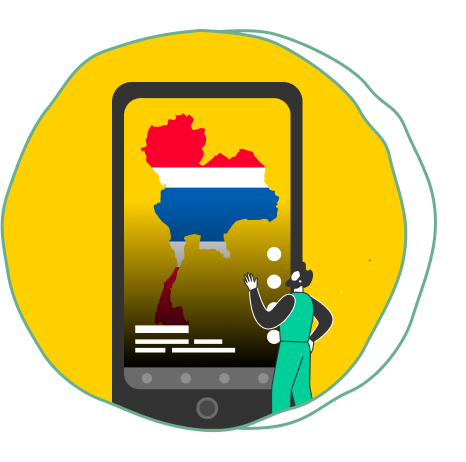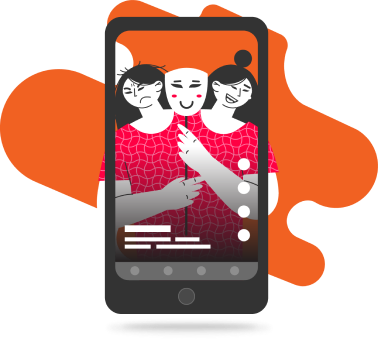TikTok in Thailand
Activists in Thailand are advancing social justice 15 seconds at a time.

This article was written by AGO Engagement Manager Danielle Reid based on research conducted by AGO collaborator Nat Sumon.

Earlier this year, rising rap superstar Milli became the first artist to face serious prison time under Thailand’s controversial Computer-Related Crime Act (CCA). The Ministry of Defense charged her with threatening national security for criticizing the federal government’s response to COVID-19.
Young activists immediately took to social media to protest with the hashtag #SaveMilli. Soon, it was the top trending topic on TikTok and content with the #SaveMilli hashtag was racking up tens of millions of views. Within 48 hours, at the peak of social media activity, Milli was released with a minor charge.
In Thailand, social media is a powerful tool for educating people and growing movements. On Facebook, activists create groups and pages to function as digital hubs for sharing information and coordinating events. On Instagram, image-based storytelling pairs photos and long-form text to activate both new and reliable audiences. Twitter, birthplace of the now ubiquitous hashtag, is a nexus for breaking news, hot takes, expert commentary, live documentation, and public engagement with key players close to the issues.
TikTok is, in many ways, an amalgamation of its predecessors. It builds on some of their most popular features—convenient mechanisms for visual storytelling and hashtags—with creative tools that people can use to incorporate music, humor, and clever creative effects.
TikTok is massively popular with young Thais, and Professor Thitirat Thipsamritkul, Lecturer, Faculty of Law, Thammasat University, suspects it has to do with this fun factor.
“Traditional mainstream media doesn’t respond to the demand of the young generation,” she says, noting that while she follows digital law and online freedom, she isn’t specifically an expert on social media. “TikTok started as pure entertainment, especially during Covid-19 lockdown with dance and challenges. It’s also a place to follow celebrities.”
Because young people generally occupy the driver’s seat in social movements—Professor Thipsamritkul notes that K-pop fanclubs on Twitter were one of the main drivers of the student movement of 2020 in Thailand—TikTok has also become a powerful medium for activists to express ideas and generate dialogue about social issues.

Drawing attention to the margins

Throughout the mountains of Thailand’s border regions live large agricultural communities of Indigenous peoples. These ethnic minorities face systemic legal and social discrimination from Thailand’s majority ethnic group. Citizenship, for example, is notoriously difficult for them to obtain, which bars them from owning property, voting, and receiving social benefits like monthly pensions.
However, some of these communities are using TikTok to build bridges between themselves and Thailand’s majority demographic. The platform has equipped them with an entertaining, but effective, method to build presence in Thai society. Members of these ethnic minorities use it to build empathy, educate other Thai people about their way of life and unique cultures, and reshape narratives around what it means to be Indigenous.
Karen youth have particularly used TikTok to showcase their culture and promote inclusivity to great success. The most viral hashtags pertaining to the Karen people have earned over 200 million views. Typical posts include depictions of traditional dances, educational segments on Karen history, and outtakes from everyday life. For many Thai TikTok users, this is their first positive exposure to Indigenous culture. The majority of public commentary on Karen social posts is positive and inquisitive, suggesting the platform has activated an authentic interest among younger demographics to learn more about the social struggles of these historically marginalized people.
While cultural awareness around ethnic minorities hasn’t yet translated into consistent activism, TikTok has given Indigenous activists a platform they can use to mobilize for justice.
For example, Thai activists amplified the story of Billy Porlajee, a land rights activists arrested and murdered by government officials. In 2020, years after his death, his name and story emerged across Thai TikTok to bring awareness to forced disappearances by the Thai government. More recently, Karen youth and sympathetic supporters used TikTok to raise awareness of the forced displacement of Karen people from their ancestral homeland of Bang Kloy. They educated the public on the government’s actions and highlighted protest activity using the hashtag #saveบางกลอย (#savebangkloi), which received over 5 million views.
However, some of these communities are using TikTok to build bridges between themselves and Thailand’s majority demographic. The platform has equipped them with an entertaining, but effective, method to build presence in Thai society. Members of these ethnic minorities use it to build empathy, educate other Thai people about their way of life and unique cultures, and reshape narratives around what it means to be Indigenous.
Karen youth have particularly used TikTok to showcase their culture and promote inclusivity to great success. The most viral hashtags pertaining to the Karen people have earned over 200 million views. Typical posts include depictions of traditional dances, educational segments on Karen history, and outtakes from everyday life. For many Thai TikTok users, this is their first positive exposure to Indigenous culture. The majority of public commentary on Karen social posts is positive and inquisitive, suggesting the platform has activated an authentic interest among younger demographics to learn more about the social struggles of these historically marginalized people.
While cultural awareness around ethnic minorities hasn’t yet translated into consistent activism, TikTok has given Indigenous activists a platform they can use to mobilize for justice.
For example, Thai activists amplified the story of Billy Porlajee, a land rights activists arrested and murdered by government officials. In 2020, years after his death, his name and story emerged across Thai TikTok to bring awareness to forced disappearances by the Thai government. More recently, Karen youth and sympathetic supporters used TikTok to raise awareness of the forced displacement of Karen people from their ancestral homeland of Bang Kloy. They educated the public on the government’s actions and highlighted protest activity using the hashtag #saveบางกลอย (#savebangkloi), which received over 5 million views.


Striking the right balance

The things that make TikTok so great for social advocacy—that clips are entertaining and require such a short investment of time—also limit its applications. The lighthearted nature of the app can make it challenging for activists to discuss serious matters without alienating viewers over time, and the format is challenging for activists speaking to dense topics. TikTok allows users to post 15-second, 1-minute, and 3-minute videos, but shorter videos still yield the best results.
Consequently, activists often focus content on top-level narratives that remind viewers of key issues in society but lack the emotional details, anecdotes, and imagery that can more effectively move people to action. They feel they must strike a balance between building content within the merry TikTok atmosphere and conveying the urgency of their subject matter—or risk losing their base.
Professor Thipsamritkul suggests that TikTok often works in concert with other platforms, like Twitter, as a bridge to more serious or in-depth content.
“Many [young people and activists] use TikTok in combination with Twitter—their video and text functions complement each other,” she says. “And we see a lot of TikTok content being even more viral because it’s shared on other platforms.”
Consequently, activists often focus content on top-level narratives that remind viewers of key issues in society but lack the emotional details, anecdotes, and imagery that can more effectively move people to action. They feel they must strike a balance between building content within the merry TikTok atmosphere and conveying the urgency of their subject matter—or risk losing their base.
Professor Thipsamritkul suggests that TikTok often works in concert with other platforms, like Twitter, as a bridge to more serious or in-depth content.
“Many [young people and activists] use TikTok in combination with Twitter—their video and text functions complement each other,” she says. “And we see a lot of TikTok content being even more viral because it’s shared on other platforms.”

What you can learn

While TikTok is not ideal for deep dives into sensitive topics, it’s great for piquing interest and raising awareness. Here’s what we can learn from the success Thai activists are having with TikTok:
- Keep it light. People view TikTok as a source of entertainment. Lean into this, using TikTok as a bridge to serious discourse rather than a platform for it.
- Keep it brief. The sweet spot for views is 6-9 seconds, and it’s rare that videos beyond 60-seconds make it to TikTok’s FYP (“for you” page). Use TikTok to guide viewers to external resources more suitable for deep education.
- Get creative. TikTok is an awesome platform for experimentation. Get creative, goofy, weird, surprising, and bold. The more inventive, the better.
- Find an angle. Find an angle that will be relevant to the community you’re hoping to mobilize.
- Use hashtags. Make them witty, memorable, and relevant. You can also tap into trending hashtags to reach a larger audience.

Sign up for our lightweight newsletter
Insights and resources for important work